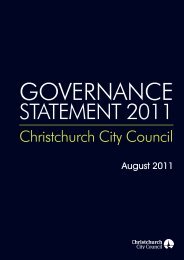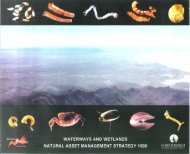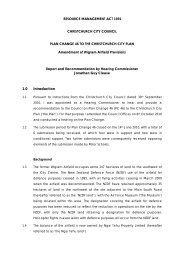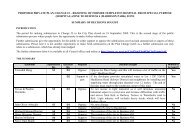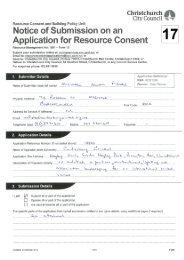Annual Report 2010 - Christchurch City Council
Annual Report 2010 - Christchurch City Council
Annual Report 2010 - Christchurch City Council
You also want an ePaper? Increase the reach of your titles
YUMPU automatically turns print PDFs into web optimized ePapers that Google loves.
Statement of<br />
accounting policies<br />
(continued)<br />
Financial statements<br />
<strong>Annual</strong> <strong>Report</strong><br />
<strong>Christchurch</strong> Otautahi<br />
<strong>2010</strong><br />
p145.<br />
Notes to financial statements<br />
1. Statement of accounting policies (continued)<br />
Derivative financial instruments<br />
The <strong>Council</strong> uses derivative financial instruments to hedge its<br />
exposure to interest rate and foreign exchange risks arising from<br />
operational, financing and investment activities. In accordance<br />
with the treasury policies of the respective group entities, the<br />
<strong>Council</strong> does not hold or issue derivative financial instruments<br />
for trading purposes. However, derivatives that do not qualify for<br />
hedge accounting are accounted for as trading instruments.<br />
Derivative financial instruments are recognised initially at fair<br />
value. Subsequent to initial recognition, derivative financial<br />
instruments are stated at fair value. The gain or loss on<br />
re-measurement to fair value is recognised immediately in profit<br />
or loss. However, where derivatives qualify for hedge accounting,<br />
recognition of any resultant gain or loss depends on the nature of<br />
the item being hedged (see Hedging policy).<br />
The fair value of interest rate swaps is the estimated amount that<br />
the group would receive or pay to terminate the swap at the balance<br />
sheet date, taking into account current interest rates and the<br />
current creditworthiness of the swap counterparties. The fair value<br />
of forward exchange contracts is their quoted market price at the<br />
balance sheet date, being the present value of the quoted forward<br />
price.<br />
Hedging<br />
Derivatives are first recognised at fair value on the date a contract<br />
is entered into and are subsequently remeasured to their fair value.<br />
The method of recognising the resulting gain or loss depends on<br />
whether the derivative is designated as a hedging instrument,<br />
and if so, the nature of the item being hedged. The <strong>Council</strong><br />
designates certain derivatives as either; (1) hedges of the fair value<br />
of recognised assets or liabilities or a firm commitment (fair value<br />
hedge); or (2) hedges of highly probable forecast transactions (cash<br />
flow hedges).<br />
The <strong>Council</strong> documents the relationship between hedging<br />
instruments and hedged items at the inception of the transaction,<br />
as well as its risk management objective and strategy for<br />
undertaking various hedge transactions.<br />
The <strong>Council</strong> also documents its assessment, both at hedge<br />
inception and on an ongoing basis, of whether the derivatives that<br />
are used in hedging transactions have been and will continue to be<br />
highly effective in offsetting changes in fair values or cash flows of<br />
hedged items.<br />
(i) Fair value hedge<br />
Changes in the fair value of derivatives that are designated and<br />
qualify as fair value hedges are recorded in the profit and loss,<br />
together with any changes in the fair value of the hedged asset<br />
or liability that are attributable to the hedged risk.<br />
(ii) Cash flow hedge<br />
The effective portion of changes in the fair value of derivatives<br />
that are designated and qualify as cash flow hedges is<br />
recognised in equity in the hedging reserve. The gain or loss<br />
relating to the ineffective portion is recognised immediately in<br />
the profit and loss.<br />
Amounts accumulated in equity are recycled through profit or<br />
loss in the periods when the hedged item will affect profit or<br />
loss (for instance when the forecast sale that is hedged takes<br />
place). However, when the forecast transaction that is hedged<br />
results in the recognition of a non financial asset (for example,<br />
inventory) or a non financial liability, the gains and losses<br />
previously deferred in equity are transferred from equity and<br />
included in the measurement of the initial cost or carrying<br />
amount of the asset or liability.<br />
When a hedging instrument expires or is sold or cancelled,<br />
or when a hedge no longer meets the criteria for hedge<br />
accounting, any cumulative gain or loss existing in equity at<br />
that time remains in equity and is recognised when the forecast<br />
transaction is ultimately recognised through profit and loss.<br />
When a forecast transaction is no longer expected to occur,<br />
the cumulative gain or loss that was reported in equity is<br />
immediately transferred to the statement of comprehensive<br />
income.<br />
(iii) Derivatives that do not qualify for hedge accounting<br />
Certain derivative instruments do not qualify for hedge<br />
accounting. Changes in the fair value of any derivative<br />
instrument that does not qualify for hedge accounting are<br />
recognised immediately in the profit and loss.





